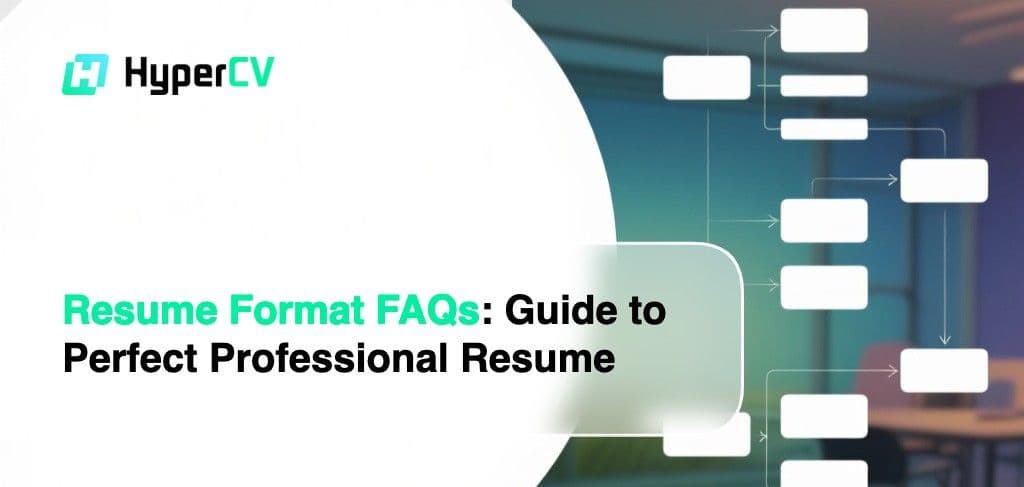Resume Format FAQs: Your Complete Guide to Professional Resume Setup

Creating the perfect resume can feel overwhelming, especially when you're not sure which format to choose. The way you organize your information can make or break your chances of landing that dream job. Let's dive into the most common questions about resume formats and help you make the right choice for your career.
Understanding Resume Format Basics
When you build your resume, the format you choose tells a story about your career journey. Think of your resume format as the foundation of your professional presentation. It's not just about looking good—it's about making it easy for hiring managers to find what they're looking for quickly.
The truth is, most employers spend only 6-8 seconds scanning a resume before deciding whether to keep reading. That's why having the right format matters so much. Your format should highlight your strongest qualifications while making the document easy to read and navigate.
According to Resume.org's comprehensive guide, the best resume format will vary according to your years of experience, industry, and long-term career goals. You can choose from three types of resume formats: reverse chronological, functional, and combination. Each approach has its own distinct qualities and objectives.
The Three Main Resume Format Types
Chronological Resume Format: The Classic Choice
The chronological format remains the gold standard in American job markets. This approach lists your work history in reverse order, starting with your most recent position. It's like telling your career story from today backward, which makes sense to most hiring managers.
This format works particularly well when you have steady employment history and want to show career progression. Your work experience takes center stage, while other sections like education and skills support your main narrative.
As experts at Indeed explain, a chronological resume is a resume format that lists your professional experience in reverse-chronological order, beginning with your most recent position and continuing in descending order. This type of resume prioritizes your relevant professional experience and achievements.
Best for: People with consistent work history, career changers moving up in the same field, and anyone applying to traditional industries.
Functional Resume Format: Skills Take the Lead
A functional format flips the script by putting your skills front and center. Instead of leading with job titles and dates, you organize your experience around key abilities and achievements. This approach can be powerful when used correctly.
Many people think functional resumes are only for those with employment gaps, but that's not entirely true. They can also work well for career changers who want to emphasize transferable skills over specific job titles.
According to ResumeGenius, the functional resume format focuses heavily on your relevant skills instead of your work experience, which is why it's also known as a skills-based resume. If you're like most students or recent college graduates, you don't have much formal work experience yet, so your education is the core of your resume.
Best for: Career changers, people returning to work after time off, or those with non-traditional career paths.
Combination Format: Getting the Best of Both Worlds
The combination format tries to capture the strengths of both chronological and functional approaches. You start with a robust skills section, then follow with a detailed work history. It's like having two resumes in one.
This format requires careful balance. You need enough space to showcase both your skills and experience without making the document too long or crowded.
As noted by ResumeBuilder, this resume format combines the reverse chronological and functional styles. To write an eye-catching hybrid resume, fuse the best aspects of both the reverse chronological and functional formats. This is also known as the combination resume format, as it allows you to feature your professional experience, skills, and certifications according to your career needs.
Best for: Experienced professionals with diverse skill sets and those in fields where both technical abilities and work history matter equally.
Resume Format FAQs: The Most Common Questions
Which Resume Format Do Most Employers Prefer?
The chronological format wins hands down. Studies show that about 85% of hiring managers prefer this traditional approach. Why? It's familiar, easy to scan, and provides a clear timeline of your professional growth.
Applicant Tracking Systems (ATS) also handle chronological resumes better than other formats. Since many companies use these systems to screen applications, choosing an ATS-friendly format gives you a better chance of getting past the initial screening.
Matt Glodz, a Certified Professional Resume Writer who studied business communication at Cornell University and worked within Fortune 500 companies, notes through Resume Pilots that qualified candidates are frequently denied interview opportunities due to poorly written documents. He emphasizes that the chronological format is generally recommended for its clarity and familiarity.

How Do I Know Which Format Is Right for Me?
Your career situation should guide your format choice. Here's a simple decision tree:
- Steady work history with clear progression? Go chronological.
- Career gaps or changing industries? Consider functional.
- Extensive experience in multiple areas? Try combination.
- New graduate or entry-level? Stick with chronological but lead with education.
Can I Use Different Formats for Different Jobs?
Absolutely! Smart job seekers often maintain multiple versions of their resume. You might use a chronological format for most applications but switch to functional when applying to a completely different industry.
Just remember to keep your core information consistent across all versions. The format may change, but your employment dates, job titles, and achievements should remain accurate.
What About Creative or Modern Resume Formats?
Creative formats can work well in certain industries like graphic design, marketing, or entertainment. However, they come with risks. Many ATS systems struggle with unusual layouts, graphics, or non-standard formatting.
If you work in a creative field, consider having two versions: a creative one for human reviewers and a simple, ATS-friendly version for online applications.
Resume Format Elements That Make a Difference
Essential Sections Every Resume Needs
Regardless of format, certain sections are non-negotiable:
- Contact Information: Keep it current and professional
- Professional Summary or Objective: A brief overview of your value proposition
- Work Experience: Your professional history with quantifiable achievements
- Education: Degrees, certifications, and relevant training
- Skills: Technical and soft skills relevant to your target role
Design Elements That Enhance Readability
Good formatting isn't just about section order—it's also about visual design. Use consistent fonts, appropriate white space, and clear headings. Bullet points make information easier to digest than long paragraphs.
Keep font sizes between 10-12 points for body text and slightly larger for headings. Stick to professional fonts like Arial, Calibri, or Times New Roman. Fancy fonts might look interesting, but they can cause problems with ATS systems.
As highlighted by Indeed's formatting guide, a significant difference between a chronological resume and a functional resume is the physical appearance. Your resume format dictates what information to include and how to position it on the document.
Common Resume Format Mistakes to Avoid
Formatting Inconsistencies
One of the biggest mistakes people make is inconsistent formatting. If you bold one job title, bold them all. If you use bullet points in one section, use them throughout. These details matter more than you might think.
Overcrowding Your Resume
Trying to fit too much information creates a cluttered, hard-to-read document. White space is your friend—it helps important information stand out and makes your resume more pleasant to read.
Using the Wrong Format for Your Situation
Don't choose a format just because it looks interesting. A functional resume might seem like a good way to hide employment gaps, but many employers are suspicious of this format. It's often better to address gaps honestly in a cover letter while using a chronological format.
Industry-Specific Format Considerations
Traditional Industries
Fields like finance, law, and healthcare typically prefer conservative, chronological formats. Clean, simple designs work best. Save the creativity for industries that value innovation.
Creative Industries
Marketing, design, and media companies often appreciate more creative approaches. However, even in these fields, readability should come first. Your resume needs to communicate effectively before it can impress aesthetically.
Tech Industry
Tech companies usually care more about skills than design flair. A clean, well-organized resume that clearly shows your technical abilities and project experience works best.
File Format Considerations
Most experts recommend having both Word and PDF versions of your resume. Word documents are often more ATS-friendly, while PDFs preserve your formatting across different devices and operating systems.
When in doubt, follow the application instructions. If an employer asks for a specific format, always comply with their request.
| Format Type | Best For | ATS Friendly | Time to Create |
|---|---|---|---|
| Chronological | Steady work history | High | Medium |
| Functional | Career changes, gaps | Medium | High |
| Combination | Diverse experience | Medium | High |
Making Your Format Choice
Choosing the right resume format isn't about following trends—it's about presenting your unique career story in the most compelling way possible. Consider your audience, your industry, and your career goals when making this decision.
Remember, the best format is the one that gets you interviews. If you're not getting responses with your current format, it might be time to try a different approach. Don't be afraid to experiment, but always prioritize clarity and readability over flashy design.
For additional guidance, career experts like those featured on BeamJobs provide comprehensive guidance on choosing the best resume format for 2025, emphasizing the most effective options for different professional situations.
The key to resume success lies in matching your format choice to your career situation and target industry. Whether you choose chronological, functional, or combination, make sure your resume tells a clear, compelling story about your professional value. After all, your resume format should enhance your story, not overshadow it.